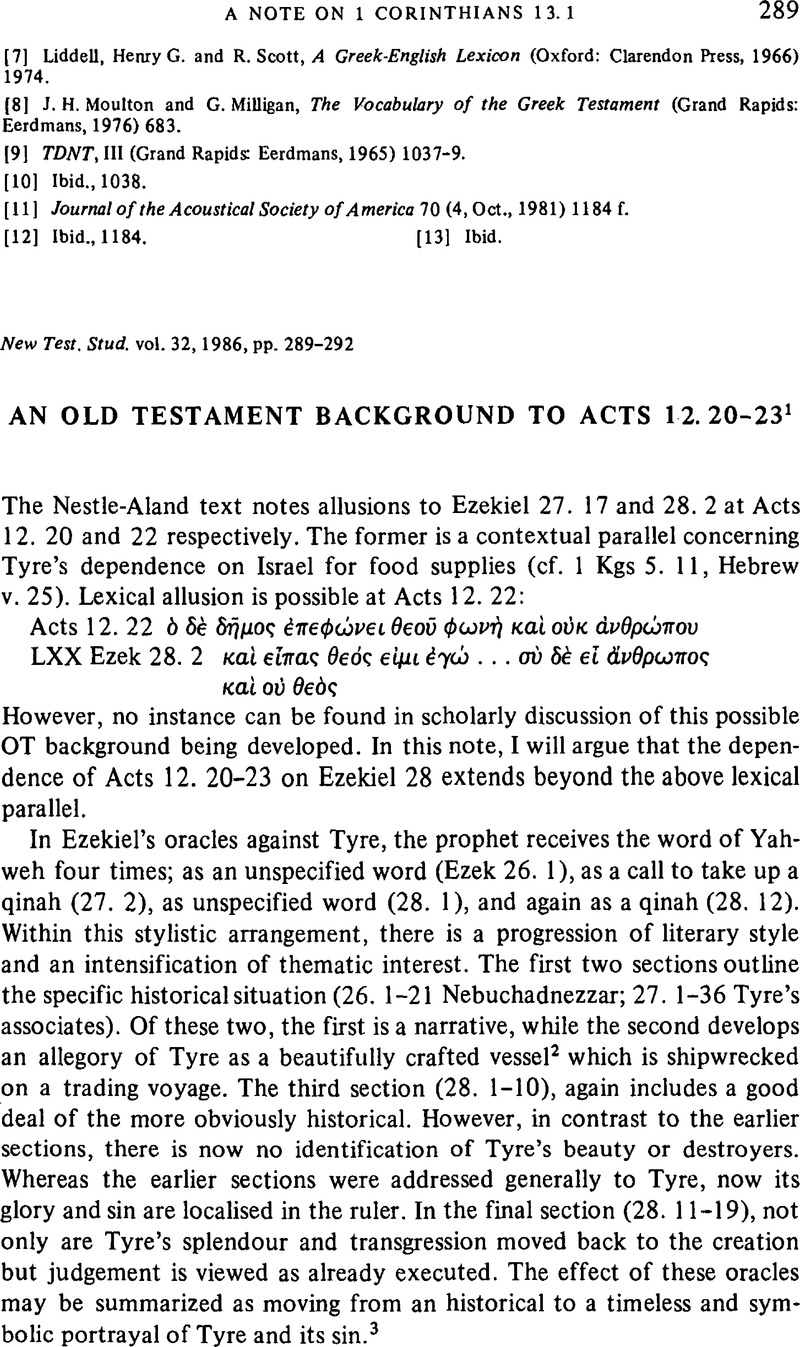Article contents
An Old Testament Background to Acts 12. 20–231
Published online by Cambridge University Press: 05 February 2009
Abstract

- Type
- Short Studies
- Information
- Copyright
- Copyright © Cambridge University Press 1986
References
Notes
[2] For a helpful discussion of the forcefulness and suitability of Ezekiel's use of this metaphor, cf. Good, E. M., ‘Ezekiel's Ship: Some Extended Metaphors in the Old Testament’, Semitics 1 (1970) 79–103.Google Scholar
[3] Yates, D. R. has related Ezekiel 28 to the overall anthropology of Ezekiel, arguing that the prophet makes use of an eschatological framework to exceed covenantal and historical restrictions in his portrayal of man, cf. ‘The Eschatological Message Concerning Man in the Book of Ezekiel’ (Ph.D. dissertation, Boston University, 1972).Google Scholar
[4] Cf. Yaron, K., ‘The Dirge over the King of Tyre’, ASTI 3 (1964) 28–57Google Scholar, Habel, N. C., ‘Ezekiel 28 and the Fall of the First Man’, CTM 38 (1967) 516–24Google Scholar, Zimmerli, W., Ezechiel 25–48, BKAT (Neukirchen: Verlag des Erziehungsverein, 1969)Google Scholar 683 and Williams, A. J., ‘The Mythological Background of Ezekiel 28: 12–19’, BTB 6 (1976) 49–61.Google Scholar
[5] Cf. Yaron, , ‘Dirge’, 31.Google Scholar The pointing of ![]() ℵ is one of the most vexed questions of this passage. If
ℵ is one of the most vexed questions of this passage. If ![]() , then the cherub seems identified with the king and the pointing of
, then the cherub seems identified with the king and the pointing of ![]() ℸℶℵ (v. 16) remains as in MT (i.e. the Lord kills the cherub). However, if it is read as
ℸℶℵ (v. 16) remains as in MT (i.e. the Lord kills the cherub). However, if it is read as ![]() (LXX μετά), then the cherub is not the king, but the Lord's instrument of execution (
(LXX μετά), then the cherub is not the king, but the Lord's instrument of execution (![]() ℸℶℵ in v. 16 will therefore have to be emended as 3ms). I have chosen to follow the LXX, though the MT is not impossible even if very difficult. The feminine (
ℸℶℵ in v. 16 will therefore have to be emended as 3ms). I have chosen to follow the LXX, though the MT is not impossible even if very difficult. The feminine (![]() ) is certainly an unusual understanding of ℶiιℸ
) is certainly an unusual understanding of ℶiιℸ![]() . Not only is the evidence for the masculine use of
. Not only is the evidence for the masculine use of ![]() scanty (cf. Num 11. 15; Deut 5. 24), but within Ezekiel 28 the masculine form (
scanty (cf. Num 11. 15; Deut 5. 24), but within Ezekiel 28 the masculine form (![]() ) is used consistently in every other instance (cf. vv. 2b, 3, 9, 12b, 15). Furthermore, it is inadequate to argue that Ezekiel would have used
) is used consistently in every other instance (cf. vv. 2b, 3, 9, 12b, 15). Furthermore, it is inadequate to argue that Ezekiel would have used ![]() if he meant ‘with’, since he consistently uses
if he meant ‘with’, since he consistently uses ![]() for this meaning.
for this meaning.
[6] Cf. Roloff, J., Die Apostelgeschichte, NTD 5 (Göttingen: Vandenhoeck und Ruprecht, 1981) 188.Google Scholar
[7] In addition to the work of Roloff, the motif of hubris has also been discussed by several other scholars in Acts 12 though the connection to Ezekiel 28 remained unexplored, cf. Nestle, W., ‘Legenden vom Tod Gottesverachter’, ARW 33 (1936) 263–9Google Scholar, Conzelmann, H., Die Apostelgeschichte, HNT 7 (Tübingen: J. C. B. Mohr, 1963) 71Google Scholar and Schneider, G., Die Apostelgeschichte II, HTKNT 5 (Freiburg: Herder, 1982) 101, 107–9.Google Scholar
- 2
- Cited by




